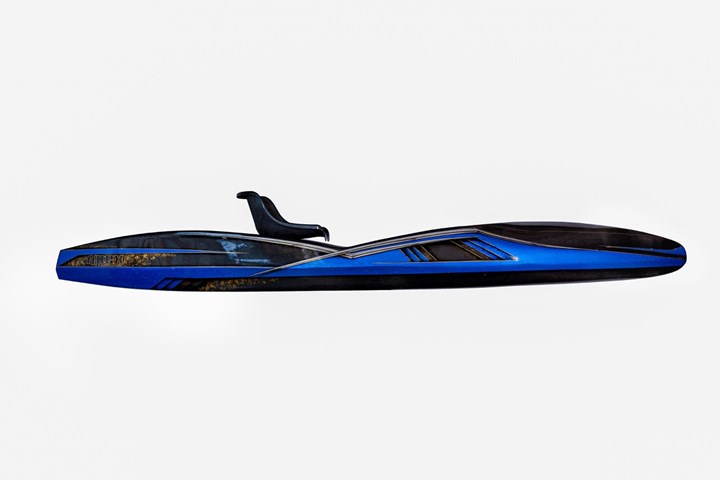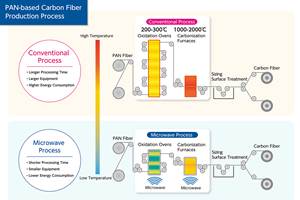Designing the ultimate stand-up fishing kayak
Apex Watercraft’s new Tyr carbon fiber/epoxy prototype reimagines the typical kayak design and promises the highest performance possible.

The carbon fiber/epoxy Tyr fishing kayak promises top-of-the-line performance. Source | Apex Watercraft
Apex Watercraft (Rock Island, Tenn., U.S.) was founded in January 2020 by Eric Jackson, a lifelong kayak competitor and designer. Having competed with high-performance, highly durable carbon fiber kayaks like the 15-pound kayak he raced in the 1992 Olympics, Jackson has set out with his new company to create an all-composite, stand-up fishing kayak that matches the light weight and high performance of racing kayaks with a design that’s simple to use. Despite a few setbacks this spring arising from the start of the coronavirus pandemic, Apex introduced its carbon fiber composite Tyr fishing kayak prototype in June through a Kickstarter campaign.
At its 3,000-square-foot facility on Rock Island outside of Campaign, Tennessee, Apex’s team — a mix of designers, kayak experts and engineers experienced in the composites industry — used CAD software to rethink the design of a stand-up fishing kayak. To achieve the stability needed to stand up while fishing, standard plastic kayaks typically feature a rounded hull designed with holes in the kayak — called scupper holes — to drain off any water that gets into the boat. The Apex team envisioned a planing hull design, meaning the kayak is level with the water on one end to ease entry to the kayak and loading of equipment. A planing hull, Jackson says, is also more stable, reduces draft, enables the kayak to travel faster and is more maneuverable than typical kayak hulls.

The Apex Watercraft team — calling themselves the “Apex Party — consists of Russ Emanis, the lead on composites for both R+D and manufacturing, Bob Blair on Hull design, Colton Breeding on small part design and manufacturing as well as plant management, Craig Heflin on accessories and Mark Nordstrom on the seat design. Source | Apex Watercraft
“Because composite parts can be made super stiff with core materials, we were able to create a full planing hull with no scupper holes in it,” Jackson says. He adds, “Plastic kayaks would be too flimsy to hold their shape if they were designed with the hull shape of my Apex watercraft.”
The 12-foot, 10-inch Tyr kayak also features a unique fin design, tracking system, cork decking, more efficient storage design and magnets within the inside walls of the boat for easy storage of scissors, pliers and other metal fishing tools.
Intrinsic to the overall design is the use of fiber-reinforced polymer instead of plastic — a design choice which drives up the price but that adds the stiffness, light weight and durability Apex Watercraft is aiming for.
“While the chance of breaking a carbon fiber kayak and needing repairing is greater than a plastic boat, the overall longevity is typically much longer,” Jackson says. “It can be repaired easily by the owner and doesn’t ‘wear down’ like a plastic boat. Plastic boats that get much use in shallow water simply lose too much plastic over a big enough area to make repairing it impractical for most people. A high impact epoxy/carbon/Innegra kayak is something you can keep around for a long time.”

The signature Tyr logo is custom airbrushed onto each kayak. Source | Apex Watercraft
Built in March, the first prototype using the new design was cut, hand-laid, and infused with vacuum bagging. The design uses Premium Resin Tech (Port Huron, Mich., U.S.) high-impact infusion epoxy resin and Firestone (Kings Mountain, N.C., U.S.) carbon fiber twill fabric, reinforced with H45 PVC foam core and several configurations of Innegra (Greenville, S.C., U.S.) fiber where required. A protective clear coat is applied and then a custom airbrush team adds finishing touches by hand — making sure to make the carbon fiber pattern stand out.
According to Jackson, the company began making its first production boats in August. For more information, email eric@apexwatercraft.com.
Related Content
Partners recycle A350 composite production waste into adjustable-length rods for MFFD
Herone, Spiral RTC, Teijin Carbon Europe and Collins Aerospace Almere recycle A350 thermoplastic composite clips/cleats waste into rods for the all-thermoplastic composite Multifunctional Fuselage Demonstrator’s crown.
Read MoreDawn Aerospace reusable rocket-powered aircraft flies twice in one day
Eighth and ninth flights of composites-intensive Mk-II Aurora reach an altitude of 63,000 feet, demonstrates same-day reusability capability for rocket-powered systems.
Read MoreMicrowave heating for more sustainable carbon fiber
Skeptics say it won’t work — Osaka-based Microwave Chemical Co. says it already has — and continues to advance its simulation-based technology to slash energy use and emissions in manufacturing.
Read MoreCryo-compressed hydrogen, the best solution for storage and refueling stations?
Cryomotive’s CRYOGAS solution claims the highest storage density, lowest refueling cost and widest operating range without H2 losses while using one-fifth the carbon fiber required in compressed gas tanks.
Read MoreRead Next
Free-form surfacing optimizes free-style kayak
The 6-ft/1.8m-long Project 54cx kayak, made using aramid and carbon fabric-reinforced composites, weighs only 19 lb/8.6 kg.
Read More“Structured air” TPS safeguards composite structures
Powered by an 85% air/15% pure polyimide aerogel, Blueshift’s novel material system protects structures during transient thermal events from -200°C to beyond 2400°C for rockets, battery boxes and more.
Read MoreDeveloping bonded composite repair for ships, offshore units
Bureau Veritas and industry partners issue guidelines and pave the way for certification via StrengthBond Offshore project.
Read More
.jpg;width=70;height=70;mode=crop)





















